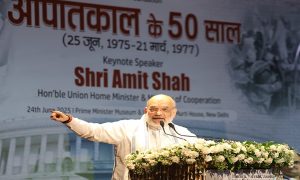Scientists at Indian Space Research Organisation performed the second of the five planned orbit-raising manoeuvre of Chandrayaan-2 in the Earth’s orbit early Friday morning.
The on-board propulsion system was fired to increase the apogee or the point on the elliptical orbit farthest from the Earth at 01:08 am.
Isro scientists were able to forgo the first orbit raising manoeuvre planned for the day after lift-off as the GSLV Mark III “over-performed” placing the spacecraft at an orbit about 6,000 km higher than intended. This would save fuel for the spacecraft, which can be used to “play around with the manoeuvre” Isro chairperson K Sivan had said after the launch.
The orbit of Chandrayaan 2 was increased to a 251 x 54,829 km from the 230 x 45,163 km it was in after the first manoeuvre. Three more “burns” or firing of the propulsion system will be carried out to reach the final orbit of 221 x 1,43,585 km on August 6.
The first manoeuvre on Wednesday was to raise the perigee or the point on the elliptical orbit closest to the Earth.
The spacecraft is scheduled to reach a lunar orbit of August 20.
“Although we have given the intended orbits for the next four manoeuvres, with each burn the numbers are likely to change. This is a very dynamic process. There is a team that recalculates the orbit every hour, there is round-the-clock simulation to plan for the next move. This is not like a launch vehicle in which we cannot make changes once launched. The spacecraft is in our control and we need to guide it to the intended orbit to escape Earth’s orbit,” said an official from Isro who asked not to be named.
Four more burns would be carried out in the lunar orbit to lower the spacecraft into a circular 100x 100 km orbit around the moon with a two-hour orbital time or time taken for the satellite to complete one orbit.
After this, the lander-rover will separate and move to a 100x30km orbit. During this period, the optical high-resolution camera on-board will be turned on to scout for a suitable landing site in the lunar south pole.
The images taken will be transmitted to Earth and processed after which the landing site map will be uploaded to the lander-rover before its powered descent to the moon on Sept 7 at 2.58am.
At 2.43pm on July 22, the 14-storey-tall GSLV Mark III rocket blasted off from the Satish Dhawan Space Centre in Andhra Pradesh’s Sriharikota with the 3,850kg Chandrayaan-2 spacecraft. Isro scientists at the Indian Space Research Organisation had a narrow one-minute window for their second attempt at launching the moon mission, a week after the first attempt was aborted just short of an hour before lift-off due to technical snag.




























 WhatsApp us
WhatsApp us